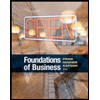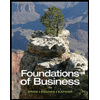
M Marketing
6th Edition
ISBN: 9781259924033
Author: Levy Grewal
Publisher: Mcgraw-Hill
expand_more
expand_more
format_list_bulleted
Question
Chapter 16.6, Problem 1PC
Summary Introduction
To determine: Components of retail strategy.
Introduction: Retail strategy refers to a marketing approach for a commodity or service which focuses on targeting and attracting consumers. It includes decisions such as pricing of the product, selection of a retail channel, and placement of product in the shop.
Expert Solution & Answer
Answer to Problem 1PC
Retail strategy aims at targeting and attracting consumers with the help of a marketing approach. The components of retail strategy are:
- Product: Goods or services provided by an establishment to its customers.
- Price: Sum of money paid by customers to acquire the product.
- Place: Task carried out to make the product accessible to the buyer.
- Promotion: Advertisement and marketing of goods to convince the buyers to buy the product.
Explanation of Solution
Mentioned below are the components of retail strategy:
- Product: Product refers to goods or services provided by an establishment to its customers, its features, and its benefits to customers.
- Price: Price refers to the sum of money paid by customers to acquire the product that is based on factors such as the cost of production of the product, its demand in the market.
- Place: Place refers to the tasks carried out to make the product accessible to the buyer through the
marketing channels , and distribution strategies. - Promotion: Promotion refers to advertisement and marketing activities undertaken to communicate about the product to the potential buyers to convince the buyers to buy the product.
Want to see more full solutions like this?
Subscribe now to access step-by-step solutions to millions of textbook problems written by subject matter experts!
Students have asked these similar questions
Culture refers to the common set of values shared by its citizens that determine what is socially acceptable.
For this assignment explore some of the key characteristics of a specific culture. You can choose a country of your choice and research as much details about their culture as possible, don’t forget to include visuals.
What country?
What is the language and culture Idioms?
Describe their customs and traditions?
What re the important values of this culture?
Summary: What do you think would be some expectations for anyone doing sales presentations in this country?
Notes and references:
What is a good response to this statement?
As we know, several global retailers target densely populated regions such as China or India as they represent emerging markets and great potential for maximum profits. As many have stated in this discussion, these retailers tend to exploit workers in these regions by utilizing the nation's lax labor laws, health and safety standards, as well as their lack of rights within the region.
However, some do not discuss the cultural appropriation or pandering that these companies exercise in an effort to maximize their profits. There are instances of companies utilizing cultural elements such as symbols, traditional designs, or culturally significant images on mass produced items without understanding the meaning or showing respect to that significant meaning. Retailers sometimes utilize these culturally significant images or symbols to maximize their profits without acknowledging where it comes from or giving back to the community they took it from.…
What is a good statement to this post?
One ethical issue that stood was how global retailers sometimes enter international markets without creating fair partnerships within their distribution channels. In Chapter 15, it talks a lot about the importance of building strong relationships with local intermediaries, but the reality is, some companies just try to dominate the market instead of collaborating. That power imbalance can lead to unfair contracts or local businesses getting pushed out. It’s like they show up, use the local resources and networks to make profit, but don’t invest back into the community or share the success. That’s not right. If you’re going to expand globally, you should be willing to build genuine partnerships, respect the local market, and not just focus on control and profit (Cateora, Gilly, & Graham, 2020). It’s all about being ethical and intentional with how you grow.
Knowledge Booster
Similar questions
- What is a good response to this comment? One major ethical issue global retailers face when expanding into markets like China and India is the risk of worker exploitation. Many retailers outsource production to factories in these regions because of lower costs, but those savings often come at the expense of labor rights. Long hours, unsafe conditions, and poverty wages are still common, especially when oversight is weak (Locke, 2013). Companies often claim ethical standards but turn a blind eye to what happens deeper in their supply chains. This disconnect damages credibility and harms real people. Ethical branding should not stop at borders. If a brand markets fairness or sustainability, it must apply those values globally or risk being seen as performative (Crane et al., 2019).arrow_forwardWhat is a good response to this comment? One major ethical issue global retailers face when expanding into markets like China and India is the risk of worker exploitation. Many retailers outsource production to factories in these regions because of lower costs, but those savings often come at the expense of labor rights. Long hours, unsafe conditions, and poverty wages are still common, especially when oversight is weak (Locke, 2013). Companies often claim ethical standards but turn a blind eye to what happens deeper in their supply chains. This disconnect damages credibility and harms real people. Ethical branding should not stop at borders. If a brand markets fairness or sustainability, it must apply those values globally or risk being seen as performative (Crane et al., 2019).arrow_forwardElizabeth Corp. sold 3,800 units of its product at a price of $92.25 per unit. The total variable cost per unit is $63, consisting of $41.50 in variable production cost and $21.50 in variable selling and administrative cost. Compute the manufacturing margin for the company under variable costing. a. $192,850 b. $94,960 c. $196,140 d. $333,900 e. ($139,180)arrow_forward
- Company: Home Depot Who is the company’s target market? What type of competitive advantages do they hold if any? SWOT analysis?arrow_forwardYour memo should include a beginning, middle and end. The beginning section of the memo should serve as an opening summary of the contents of your memo. It should be clear and concise and lay out the goal of the analysis that is presented in the memo. The main purpose of the opening is to allow the manager, in this case Mrs. Walker, to make a quick scan and determine the subject of the memo. The middle section of the memo should describe the current situation, the data used in the analysis, the method of analysis, the model used to analyze the questions and the results that were found. The discussion of the current situation should be brief, providing a context for the analysis, but not rehashing a lot of the information that the audience for the memo would already know. (For example, in the case you do not need to include the entire history of the business.) In describing the data, you should indicate which data you used and why you used it (and why you did not use some of the…arrow_forwardEthical decision making includes several influential factors, Except Question 15Answer a. Extent of problems b. Probability of Harm c. Social consensus d. All of the above e. Top management actionsarrow_forward
- _____ is the strategy of increasing sales by introducing new products into new markets. Question 10Answer a. Product penetration b. Market penetration c. Product development d. Product developmentarrow_forwardGo to the following link: Forbes TOP companies with the Best CSR reputations. https://www.forbes.com/sites/vickyvalet/2018/10/11/the-worlds-most-reputable-companies-for-corporate-responsibility-2018/#480e6d813371 Be prepare to share your findings in class. Please write your answers in complete sentences. Choose an organization with best CSR Visit the organizations website and copy link to their website below Does the company have a societal marketing orientation, or is it a company that is known solely for their corporate giving? Explain. How is this company practicing CSR? Provide examples Discuss how customers would know this company is a socially responsible company by looking at their website. Please provide examples of your findings below.arrow_forward1. Explain the role of social media in communication? 2. What are the three types of communication thru social media? 3. Provide a picture demonstrating one type of social media communication for an organization of your choicearrow_forward
- Find a commercial of your choice on YouTube. www.youtube.com (Make sure it is appropriate). Tell me about the target market of your organizations marketing mix. Copy the video link here: Who is the organization? What is the product or service? Who is the specific demographic for your target market? List all and give me a brief explanation how you came to your conclusion. Example: Teens? Generation x? Y? Baby boomers? Who? Are there any social factors that influence the specific market? Are there any ethnic factors? Are there any economic factors? Are there any political and legal factors? Example: FDA regulations?arrow_forwardAlmost since the foundation of the Girl Scouts of the United States of America in 1912, cookie sales have played a major role in supporting the Girl Scouts organization at the council and troop levels. By now, cookie sales have grown into a major moneymaking operation, bringing in over $714 million per year. Recent years, however, have seen cookie sales lagging with nearly six years of year over-year declines of about 1 percent each until the trend reversed last year. The recent economic downturn hasn’t helped matters either. After a restructuring of its operations in 2004, the Girl Scouts have made several changes to the program that they hope will help spark sales and create cost-saving opportunities. This year, Girl Scout troops will be selling cookie boxes at $4 even, up from the $3.50 price tag mandated in 2006. Before that, local councils were allowed to set their own prices, resulting in price wars as some troops attempted to undercut each other to increase sales. Portions on…arrow_forwardRae, M., (2021). Building ethical supply chains: The case of H&M in China. In SAGE Business Cases.Links to an external site. SAGE Publications, Ltd. create a 2–4-minute word document to video record discussing the details for the assignment noted below. Be creative and use effective communication skills. Post the references used as a separate Word document. Make sure you structure your video in the following manner: Introduction Provide a brief case summary Situation Describe the details of the situation, making sure to include information on who, what, why, when, and how. You need to bridge the gap between one’s knowledge and the ability to form a hypothesis. Problems - Identify and provide a thorough explanation of the perceived and underlying problems, as well as the potential long-term effects. Alternatives - Discuss alternatives or strategies that the company could implement. Include more than one alternative, detailing the advantages/disadvantages of each and…arrow_forward
arrow_back_ios
SEE MORE QUESTIONS
arrow_forward_ios
Recommended textbooks for you
 Contemporary MarketingMarketingISBN:9780357033777Author:Louis E. Boone, David L. KurtzPublisher:Cengage LearningMarketingMarketingISBN:9780357033791Author:Pride, William MPublisher:South Western Educational Publishing
Contemporary MarketingMarketingISBN:9780357033777Author:Louis E. Boone, David L. KurtzPublisher:Cengage LearningMarketingMarketingISBN:9780357033791Author:Pride, William MPublisher:South Western Educational Publishing Foundations of Business (MindTap Course List)MarketingISBN:9781337386920Author:William M. Pride, Robert J. Hughes, Jack R. KapoorPublisher:Cengage Learning
Foundations of Business (MindTap Course List)MarketingISBN:9781337386920Author:William M. Pride, Robert J. Hughes, Jack R. KapoorPublisher:Cengage Learning Foundations of Business - Standalone book (MindTa...MarketingISBN:9781285193946Author:William M. Pride, Robert J. Hughes, Jack R. KapoorPublisher:Cengage Learning
Foundations of Business - Standalone book (MindTa...MarketingISBN:9781285193946Author:William M. Pride, Robert J. Hughes, Jack R. KapoorPublisher:Cengage Learning

Contemporary Marketing
Marketing
ISBN:9780357033777
Author:Louis E. Boone, David L. Kurtz
Publisher:Cengage Learning

Marketing
Marketing
ISBN:9780357033791
Author:Pride, William M
Publisher:South Western Educational Publishing


Foundations of Business (MindTap Course List)
Marketing
ISBN:9781337386920
Author:William M. Pride, Robert J. Hughes, Jack R. Kapoor
Publisher:Cengage Learning

Foundations of Business - Standalone book (MindTa...
Marketing
ISBN:9781285193946
Author:William M. Pride, Robert J. Hughes, Jack R. Kapoor
Publisher:Cengage Learning
